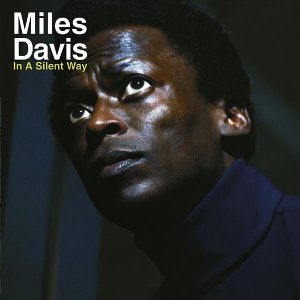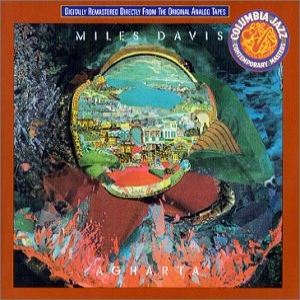June 06, 2005
Miles Davis: In a Silent Way
When I was in Sydney recently I bought a copy of In A Silent Way (1969) by Miles Davis.
 This CD marked the point at which Miles left conventional forms of jazz behind altogether, and moved into completely new ground---ambient jazz. I have not heard the complete sessions, but I understand that this record is final product of elaborate editing and postproduction work by Teo Macero and Miles Davis. Still it is a far cry from the improvisational rock 'n roll of 1970 Grateful Dead.
This CD marked the point at which Miles left conventional forms of jazz behind altogether, and moved into completely new ground---ambient jazz. I have not heard the complete sessions, but I understand that this record is final product of elaborate editing and postproduction work by Teo Macero and Miles Davis. Still it is a far cry from the improvisational rock 'n roll of 1970 Grateful Dead.
This music lead to the more aggressive electric rock/jazz fusions of Bitches Brew and A Tribute to Jack Johnson Miles connects with the youth culture of the day, delves into the 'primitive' world of rock music, opens concerts for the Grateful Dead, and influenced the live jams of the Grateful Dead.
Previously (eg., the ambient jazz of Filles De Kilimanjaro) Davis had reinvented old forms, made them his own by painting his lyrical, melancholy trumpet lines over whichever canvas he chose as his basis of expression. Music from earlier albums, such as "Solea" from Sketches of Spain, became a part of the improvisation of the Grateful Dead of 1973/1974. Did Bitches Brew influence the Dead?
In a Silent Way presented a new kind of music:
"The music itself is...free, unfettered and uncontainable, a liquid pool of keys and atmospheres from which originates a series of open-ended vamps and solos, and a rhythm that is sometimes barely present, at other times sinuously, subtly funk-inflected. There are no rules to this music, no boundaries. The players pick up on each other, establish riffs, whispers of melodies, and either leave them to dissolve or else gently breathe life into them. Shorter fills space, floating in and out of audibility, until it is his turn to articulate a moment."
Th emusic makes use of multiple keyboardists--Herbie Hancock and Chick Corea on electric piano and Joe Zawinul on organ--Davis on trumpet Wayne Shorter on soprano saxophone, Tony Williams on drums, and John McLaughlin on guitar. The music dips into rock and R&B, gospel and classical, electronics and creative editing, with Davis providing multiplies tones and melody lines and complicates textures.
In the 1970s Miles moved away from the European approach to music, to a more Afrological, spontaneous, and collective way of creating music. Miles tried to break open the logic of the music and have the rules change completely every night. Oddly enough, it was a way of music-making more akin to the Grateful Dead playing Dark Star than to conventional jazz. Just as the improvisation in Dark Star can differ greatly from night to night, and the tune part is not really that important, the Miles stuff from the mid 70's,(from '72-'75) from start to finish, is pretty much all like the middle of a really open Dark Star completely different each time it occurs.

Between Bitches Brew and A Tribute to Jack Johnson Davis was searching for an improvised form of jazz music based on Jimi Hendrix's guitar-bass-drums line-up.
Was Davis trying to play jazz by becoming a rock 'n roll band in the studio, and give the rock 'n roll bands a run for their money?
Was the task then was to create a great live rock and roll, funk ‘n jazz band.
Was that achieved in 73-75 with the Agharta band?
It was during the late 80s and early 90s that the Grateful Dead/Jazz relationship deepened, and took the form of very close encounters between the members of the Dead and some of the practitioners of jazz including Branford Marsalis, Ornette Coleman and David Murray. I haven't heard this music or the Grateful Dead's music of the late 1980s or early 1990s: I've only heard the 1980 Go To Nassau. That music was not a development in the rock jazz fusion.
Now what I am discovering as I dig around is that the band is one of the most critically maligned bands in rock 'n' roll. Radio stations rarely played the band's songs whilst mainstream media and Rolling Stone regularly panned them. The 1982 edition of the New Rolling Stone Record Guide called the Dead "a pox on the face of pop -- nostalgia mongers -- offering facile reminiscence to an audience with no memory of its own."
By 1987 the Grateful Dead had shifted from beign a cult band and quietly assimilated into the mainstream of pop culture with its 1987 In the Dark album, stadium tours and regular rotation on MTV. They had become an acceptable and inescapable part of pop culture. The 1992 edition of the Rolling Stone Album Guide began revising its musical judgements as it gave the early 1970s albums (Workingman's Dead and American Beauty) five-star ratings. However, there is little recognition in Rolling Stone of The Grateful Dead's creativity pulse in the rock jazz fusion.
Miles Davis developed the improvisational music with a backbeat, into a wat of playing that was based on cooperative effort and centralized and focused on rhythm, through Bitches Brew, Live Evil, the twin Agharta, and Pangaea and the live jam record Dark Magus. From the bits I've heard It is dense and bizarre music, but, by and large, the post Bitches Brew music is unknown to me.
From what I can gather Davis's '70s recordings have undergone a fairly radical reassessment and are now seen by many as a significant body of work, with their interesting mixture of ideas gleaned from jazz, funk and rock music as well as from experimental, "process-oriented" European composers.
From what I can make out there was a backlash against all progressive jazz after the 1970s, when musical trends turned conservative and the remnants of jazz-rock mutated into smooth contemporary jazz. The rock jazz fusion falls between stools in terms of music criticism, with hidebound jazz critics dismissing it as too much like rock music, while rock critics think of it as too much like jazz music.
Posted by Gary Sauer-Thompson at June 6, 2005 12:54 AM | TrackBack